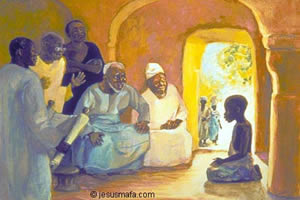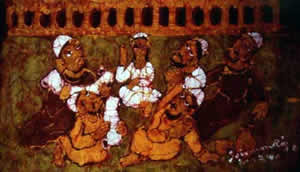The Hidden Years of Jesus:
A Spirituality of Invisibility and Obscurity
For Sunday December 31, 2006
Lectionary Readings (Revised Common Lectionary, Year C)
1 Samuel 2:18–20, 26
Psalm 148
Colossians 3:12–17
Luke 2:41–52
 |
The Boy Jesus in the Temple by He Qi (China). |
One of the curious features about the Christian story is that we know nothing about Jesus before he began his public ministry around the age of thirty. We don't know what he looked like. It's only an inference that he followed Joseph as a carpenter. Scholars speculate whether he went to school. He left not a single scrap of writing. The Gospels of Mark and John don't even include birth narratives, but begin with Jesus as an adult. John Dominic Crossan has noted that ancient biographies often start with the public lives of their subjects, skipping over earlier years as irrelevant.
Still, it's hard not to speculate, especially when you consider that Mary could have told stories about her son. In the centuries after Jesus a genre of "infancy narratives" emerged to embellish the "missing" or "hidden" years of Jesus with fanciful legends. In the Infancy Gospel of Matthew animals speak at Jesus's nativity. In the Infancy Gospel of Thomas (c. 140–170), which Anne Rice utilized in her fictional Christ the Lord (2005), Jesus curses a playground bully who consequently dies, then raises him to life with a spontaneous wish-prayer. He turns clay pots into flying birds. In the Arabic Infancy Gospel (sixth century?) Jesus's diaper heals people, and his sweat cures leprosy. Other fables claim that when Jesus was twelve he sailed to England with Joseph of Arimathea and built a church near Glastonbury to honor his mother Mary, or that between the ages of twelve to thirty he studied in India, Persia, or Tibet.
The early church rejected these fables about Jesus as spurious, and instead followed the lead of the gospel writers by contenting itself with ignorance and silence about Jesus's early years. This reticence and restraint about the hidden years of Jesus are remarkable, and reminders that the early believers were not gullible and naive when it came to sensationalist exaggerations about miracle stories. We do, however, have once brief exception to our otherwise total ignorance about the first thirty years of Jesus's life. Luke's Gospel for this week records the only canonical story we have about the years between Jesus's birth and his public ministry, and it is much more prosaic than we might wish. It is the story of the twelve-year-old Jesus in the Jerusalem temple.
 |
Jesus Among the Teachers, Jesus Mafa. |
Luke writes that every year Joseph and Mary made the 150-mile roundtrip from Nazareth to Jerusalem in order to celebrate the Feast of Passover. When he was twelve years old, about twenty miles into the return trip home to Nazareth his parents discovered that Jesus was missing from their caravan of family and friends. Any parent can imagine the terror that they must have felt when they couldn't find their son. After a second day to return to Jerusalem, on the third day they found the boy Jesus in the temple, "sitting among the teachers, listening to them and asking them questions." When Mary rebuked him it became apparent that Jesus was not accidentally lost, but that he had deliberately stayed behind: "Didn't you know that I had to be in my Father's house?" Mary and Joseph did not understand this mysterious response. After their safe return to Nazareth Jesus "was obedient to them. . . [He] grew in wisdom and stature, and in favor with God and man" (cf. 2:40).
Two points in Luke's story deserve mention. He reminds us that Jesus was a normal little boy who experienced genuine human development—physically, mentally, morally, and spiritually. Jesus's authentic humanity is precisely what the legendary "infancy narratives" obscure. The story also hints at the emergent tension between Jesus's filial identity with God the Father and his willing obedience to his earthly parents. Eventually that obedience gave way to a radical disruption, for by the time of his public ministry his own family tried to apprehend him and the entire village of Nazareth tried to kill him as a deranged crackpot (cf. Mark 3:21, Luke 4:29, John 7:5).
But that's all. These two points do nothing to fill in the thirty years of silence about the hidden years of Jesus. I like to imagine that Jesus's early life was so insignificant, so prosaic, and so secluded in obscure Nazareth that there was nothing relevant to report.
If we let Jesus's silent, missing years stand at face value instead of filling them with some deep meaning, they speak volumes in our media-saturated world of celebrity culture, self-promotion, and endless noise. His hidden years just might hold the clues to a counter-cultural "spirituality of invisibility and obscurity." For most people today (and Christians are by no means an exception), personal identity and fulfillment depend upon being well-known not unknown, visible and not invisible, acknowledged rather than ignored, important instead of insignificant, and in demand rather than out of commission. But when I consider how thoroughly "invisible" Jesus was for 90% of his life, leaving no footprint of who he was or what he did during those years, I wonder what a spirituality of obscurity, seclusion, and hiddenness might look like.
 |
Jesus in the Temple, by Solomon Raj (India), |
Most of us live hidden and unheralded lives. I think of my friend Betsy, a stay-at-home mom who left a career as an attorney in order to cook, clean, do laundry, and chauffeur five kids to the dentist, school, birthday parties and sporting events. Her husband enjoys a prestigious career. My friend Steve will remain house-bound and bedridden the rest of his life due to a debilitating disease. Claudette raised a family but now lives alone in a tiny apartment as an elderly widow. Other believers have intentionally chosen hiddenness. The Trappist monk Thomas Merton (1915–1968) spent twenty-seven years cloistered in Gethsemane Monastery in Kentucky, but nevertheless spoke to the entire world with his prophetic writings. When I visited Liberia last summer I was reminded how entire countries remain invisible to the world because they are so insignificant to the geo-political calculus of the day; you won't see a story about Liberia on CNN.
For Christians, the delicious paradox is that the missing 90% of Jesus's life, no matter how completely lost to history, was not lost or hidden to God, not by a long shot. Nor are our lives today. Liberia, Congo, and Darfur are not hidden to God, even though the world ignores them. After raising six kids and then experiencing a divorce, my mother lived by herself for thirty-three years, but none of those years were lost to God. He sees and knows; He loves and cares. He does not ask us to lament or transcend our invisibility to the world. He might even disrupt our lives by asking us to try it. However hidden and obscure our lives might feel, either literally or figuratively, whether voluntary or involuntary, in that very hiddenness He is redemptively present, just as He was with a twelve year old Jewish boy in an obscure Palestinian village.
For further reflection
* What do you think Jesus was like as a boy?
* Does our near total ignorance of his early years matter? Why?
* What do you take from Luke's story?
* Have you ever experienced hidden years?
* See Anne Rice's fictional recreation Christ the Lord (2005), "narrated" by a seven-year-old Jesus.





